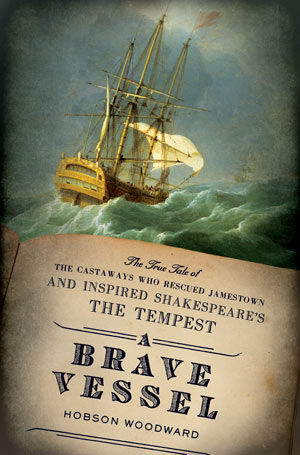
A Brave Vessel is a story of two Williams: William Strachey, a poet and would-be chronicler of the New World in 1609 London; and William Shakespeare, a playwright of uncommon wit with an eye for a good plot. The book tells the story of Strachey’s shipwreck on Bermuda during a voyage to the Jamestown colony in Virginia. A long letter home to an anonymous lady about the hurricane-tossed wreck of the Sea Venture and the months the castaways spent on the midatlantic isle found its way to Shakespeare and helped to inspire his ethereal play The Tempest. Ultimately Strachey’s hope of writing lasting literature under his own name would come to naught, but he would unknowingly contribute to the creation of a masterpiece.
The magical qualities of The Tempest have their roots in Bermuda. Even before the Sea Venture castaways arrived on the island, it was thought to be enchanted. Sailors reported strange howls in the night as they sailed past, noises Strachey would learn were the calls of nocturnal seabirds. Thunder and lightning storms were said to plague Bermuda to an unusual degree. The exotic landscape was described in the chronicles of the voyages and helped to inspire the supernatural elements of the Tempest island. Strachey also described the dancing light of St. Elmo’s fire in the rigging of the Sea Venture at the height of the storm, an account that scholars believe inspired Shakespeare’s Tempest portrait of the sprite Ariel and his luminous appearance on the shrouds of the king’s ship.
Readers of A Brave Vessel will find a story of sea voyage, shipwreck, and the settling of America. They will also discover a literary detective story. Connections between the Sea Venture chronicles and Shakespeare’s play emerge throughout the narrative. Readers have the opportunity to join a hunt for literary treasure as they travel with the voyagers to Bermuda, Virginia, and back to London.
“What emerged in my research and unfolds on the pages of A Brave Vessel is a living portrait of an infant America.”
I discovered the story of the Sea Venture while I was researching the life of Pocahontas, whose future husband was one of the Bermuda castaways. Soon after learning the broad outline of the episode, I came across William Strachey’s account of the hurricane and shipwreck. His description of the storm and his time marooned on Bermuda is a rich narrative that is rare for the era. I was captivated and never stopped digging for more details until I had researched and written A Brave Vessel.
I approached the project as an historian, but a real bonus for me was the exploration of the connections between The Tempest and the New World chronicles. Examining those correlations provided an opportunity for a greater understanding of the creative methods of the greatest playwright of the English language, insights I delight in sharing with my readers.
The search for those connections dates back to 1797, and Shakespeare scholars continue to debate their extent and significance. After immersing myself in the subject, I came away convinced that the correlations are inescapable and that they were an important catalyst in the creation of the play.
Learning about the life of William Strachey and his fellow voyagers was just as intriguing as meeting Shakespeare’s muse. The two Williams were remarkably alike in some ways: each of their families had recently become wealthy as sheep farmers; each had a mid-level education and was versed in the classics; each left a family in a country village when he came to London—Strachey leaving a wife and two sons and Shakespeare a wife and two surviving daughters; and each tended to draw upon other writers in creating their works, a common practice of the day. In the most important way, however, the two could not be more different. Few had ever heard of William Strachey, and William Shakespeare was renowned throughout the land.
Nonetheless, Strachey possessed something Shakespeare did not have—a taste for travel. He was one of the few willing to risk everything on a voyage to the New World. Strachey got more adventure than he had bargained for with a detour to Bermuda before he finally made it to Virginia. The chronicles he and his fellow adventurers wrote are a fascinating look at their lives in a wild land. They tell of what they ate, what they argued about, who they married, how two women gave birth to children on Bermuda’s sandy shore, and why they mutinied—rebelling three times before a firing squad squelched dissent.
When the castaways finally reached Virginia in two island-built boats, the chronicles tell of famine and bloody wars with the Powhatan. They also describe making wine in Jamestown, picking strawberries outside the Jamestown fort, and gorging on Chesapeake shellfish. What emerged in my research and unfolds on the pages of A Brave Vessel is a living portrait of an infant America.
If a reader were to ask where to sample a page or two of A Brave Vessel, I would suggest turning to the beginning of chapter five. At that point in the book a rogue wave sweeps the Sea Venture in the midst of a black July night. William Strachey’s description of the foaming sea pouring into the ship is one of the most thrilling passages of his narrative:
So huge a sea broke upon the poop and quarter, upon us, as it covered our ship from stern to stem like a garment or a vast cloud. It filled her brim-full for a while within, from the hatches up to the spardeck. The source or confluence of water was so violent, as it rushed and carried the helmsman from the helm and wrested the whipstaff out of his hand, which so flew from side to side that when he would have seized the same again it so tossed him from starboard to larboard as it was God’s mercy it had not split him, it so beat him from his hold and so bruised him.
The sailors manage to wrestle the ship under control and the voyage goes on. Later in the same chapter the ordeal ends when the tops of palm trees are seen on the horizon. The men, women, and children on the ship—exhausted and all but resigned to sinking beneath the sea—receive the news by an exhilarating cry from the bridge:
Admiral George Somers continued to scan the ocean, watching the waves but also looking for ships that might offer relief. He was exhausted, famished, and thirsty, but still he watched and called rudder adjustments to the helmsman below. On one of his sweeps, a movement far off caught his eye. At the crest of a swell he detected a flutter on the horizon to the west, slightly higher than the surface of the sea. The ship descended into a trough and he froze and waited for it to rise again. At the top he saw it again, and this time more clearly—above the waves, he was almost sure, he saw the tops of palm trees moving in the wind. He waited one more time as the ship dipped between swells. The consequences to morale of making a mistake would be devastating. They were far out in the Atlantic and sighting trees—while not impossible—was incredible. At the top of the next wave he saw them again and this time he was sure. Somers then let go a bellow that reached the ears of everyone on the ship, and he repeated his call, drawing out in a sustained holler the word “Land.” To the people on the Sea Venture it was a miraculous sound.
“Two Powhatans of Virginia were almost surely aboard the Sea Venture. The greatest chronicler of Jamestown, Capt. John Smith, alleged that they were present on the vessel when it wrecked, but scholars have doubted his account because he waited fifteen years to publish it. By drawing attention to a hitherto overlooked source that dates to just after the castaways returned home I was able to show that Smith was almost surely telling the truth.”
In addition to recreating the tale of the Sea Venture, much of my work in A Brave Vessel involved surveying the work of Shakespeare scholars of the last two centuries and presenting their findings alongside the full story of Strachey’s voyage for the first time.
In addition to rediscovering the work that preceded mine, I made some discoveries of my own. One of the most important was the realization that two Powhatans of Virginia were almost surely aboard the Sea Venture. The greatest chronicler of Jamestown, Capt. John Smith, alleged that they were present on the vessel when it wrecked, but scholars have doubted his account because he waited fifteen years to publish it. By drawing attention to a hitherto overlooked source that dates to just after the castaways returned home I was able to show that Smith was almost surely telling the truth.
The two Powhatans were very likely aboard the doomed vessel, and, as Smith alleges, one probably did die on Bermuda. Smith claims that one of the men murdered the other on the island. While I suggest that the “murder” was more likely a misunderstood accidental death, I nevertheless corroborate the basic facts of Smith’s long-questioned account.
One of the fascinating results of my showing that the Powhatan voyagers were almost surely on board the ship is that it is now clear that a tale of alleged murder by an island-bound Native American reached London just as Shakespeare was composing his play. He is thereby provided with a model for Caliban, the murderous wild man of The Tempest.
Literary sleuths have long seen Caliban as a portrait of a New-World man as seen through a filter of Jacobean culture. With the publication of A Brave Vessel, scholars no longer have to depend upon vague generalities when drawing that comparison. They now know that a story of a supposedly murderous New World man marooned on an enchanted isle reached Shakespeare just as he was creating his Tempest. Thus the Powhatans’ presence on the Sea Venture has as much importance to literary history as it has to the history of America.


Hobson Woodward is an associate editor of the Adams Papers at the Massachusetts Historical Society in Boston. In that role he has helped to produce seven volumes of annotated correspondence of John and Abigail Adams for use by scholars of the founding generation. During more than a decade on Nantucket, he was editor of Nantucket Magazine and a columnist for The Cape Cod Times. He has written numerous articles on historical subjects for national and regional publications.